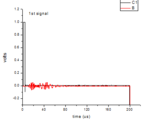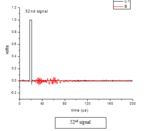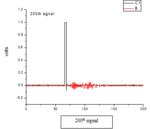syedshan
Advanced Member level 1
- Joined
- Feb 27, 2012
- Messages
- 463
- Helped
- 27
- Reputation
- 54
- Reaction score
- 26
- Trophy points
- 1,308
- Location
- Jeonju, South Korea
- Activity points
- 5,134
Hi all,
We are designing a scanning system using FPGA and currently we have unsynchronization problem and I want if someone has experience about it to please give comments over it.
Our system works as trigger is given to the FGPA, it starts to fetch data from ADC (which is continually giving out data). Hence only data after trigger is of any worth and is stored
in the FIFO.
The trigger is 500 Hz but as shown in figure that after each trigger the data is shifted and hence actually corrupted since we need the data as first figure each time.

now this figure is data after 52nd signal

and the following data is after 200 signals. Every one can clearly see that the trigger and signal are shifted wayyy forward because of which data corruption occurs.

After each trigger the wave form from ADC is stored in FIFO which I read and save into the file using c++.
One thing that I understand is may be file saving is taking lot of time and hence before next trigger comes the system is not free...
Does any one has any idea or suggestion
We are designing a scanning system using FPGA and currently we have unsynchronization problem and I want if someone has experience about it to please give comments over it.
Our system works as trigger is given to the FGPA, it starts to fetch data from ADC (which is continually giving out data). Hence only data after trigger is of any worth and is stored
in the FIFO.
The trigger is 500 Hz but as shown in figure that after each trigger the data is shifted and hence actually corrupted since we need the data as first figure each time.

now this figure is data after 52nd signal

and the following data is after 200 signals. Every one can clearly see that the trigger and signal are shifted wayyy forward because of which data corruption occurs.

After each trigger the wave form from ADC is stored in FIFO which I read and save into the file using c++.
One thing that I understand is may be file saving is taking lot of time and hence before next trigger comes the system is not free...
Does any one has any idea or suggestion